

jQuery Mobile Tutorial: User Registration, Login and Logout Screens for the Meeting Room Booking App. In this jQuery Mobile tutorial we will create the screens that will handle user registration, login and logout in a real-world Meeting Room Booking application.
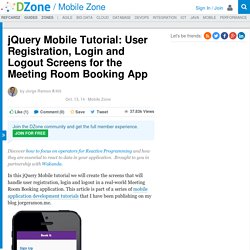
This article is part of a series of mobile application development tutorials that I have been publishing on my blog jorgeramon.me. If you are new to this series, I recommend that you read its first part, as well as thismobile UI patterns article where I provide a flowchart describing the user registration, login and logout screens in a mobile application. We will use this chart as a guide for this article. Here’s a screenshot: In this part of the tutorial we will only create the static HTML for the screens. The first step we are going to take is to set up a jQuery Mobile project for the app.
How to Set Up a jQuery Mobile Project The Project’s Directories and Files We need to pick a directory in our development workstations where we will place the project’s files. On my workstation the directories look as depicted below: <! <! <! Getting Started With jQuery (For Absolute Beginners) - Web Design Nigeria - CKDigital. Welcome to the first lesson on jQuery for absolute beginners.
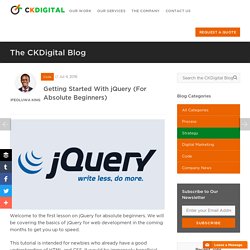
We will be covering the basics of jQuery for web development in the coming months to get you up to speed. This tutorial is intended for newbies who already have a good understanding of HTML and CSS. It would be immensely beneficial for you to at least have a very basic understanding of Javascript. We suggest you do so before committing to these lessons. One of the reasons we will be focusing on jQuery (apart from it being the most popular Javascript library) is that it’s fast; it provides simple solutions to problems that would otherwise take many many lines of code in pure Javascript.
A JavaScript library is a collection of prewritten JavaScript functions that provides simple solutions to many of the common details of JavaScript. First, download jQuery Head over to www.jquery.com Click on the download link. You will be directed to a new page. You will be greeted with this alien-looking screen. Next steps It’s really that simple. Introduction. jQuery Mobile is a touch-friendly UI framework built on jQuery Core that works across all popular mobile, tablet and desktop platforms.
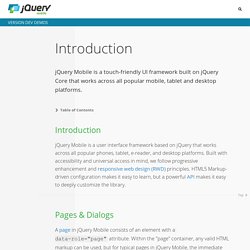
Table of Contents Introduction jQuery Mobile is a user interface framework based on jQuery that works across all popular phones, tablet, e-reader, and desktop platforms. Built with accessibility and universal access in mind, we follow progressive enhancement and responsive web design (RWD) principles. Mobile App Design/Dev: Beginner’s Guide to jQuery Mobile. Over the past 2-3 years we’ve seen a tremendous growth in browser and OS support for mobile websites.
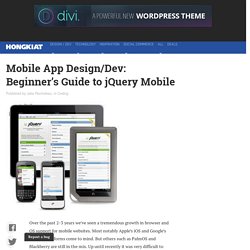
Most notably Apple’s iOS and Google’s Android platforms come to mind. But others such as PalmOS and Blackberry are still in the mix. Up until recently it was very difficult to match a single mobile theme into all of these platforms. Pin it. jQuery UI. jQuery. FancyBox - Fancy jQuery Lightbox Alternative. 10 jQuery Custom Scrollbar Plugins. JQuery vs. JavaScript: What’s the Difference Anyway? 3 reasons why you should let Google host jQuery for you. All too often, I find code similar to this when inspecting the source for public websites that use jQuery: If you’re doing this on a public facing website, you are doing it wrong.
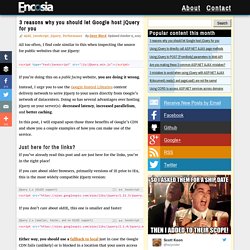
Instead, I urge you to use the Google Hosted Libraries content delivery network to serve jQuery to your users directly from Google’s network of datacenters. Doing so has several advantages over hosting jQuery on your server(s): decreased latency, increased parallelism, and better caching. In this post, I will expand upon those three benefits of Google’s CDN and show you a couple examples of how you can make use of the service. Just here for the links? If you’ve already read this post and are just here for the links, you’re in the right place! If you care about older browsers, primarily versions of IE prior to IE9, this is the most widely compatible jQuery version: jQuery 1.x (OldIE support) If you don’t care about oldIE, this one is smaller and faster: jQuery 2.x (smaller, faster, and no OldIE support) Better caching.